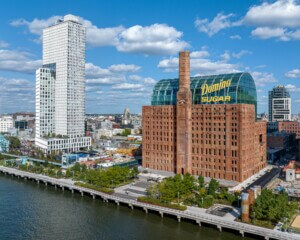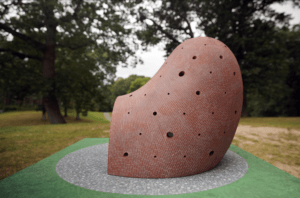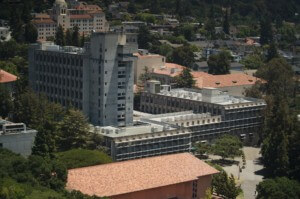The Domino Sugar Refinery has been an unmistakable element of the Brooklyn waterfront for over a century now – dating from the 1880s, the weathered brick façade, towering smokestack, sugar chutes and blown-up Domino logo are now synonymous with the landscape of Williamsburg.
In the most recent stage of the refinery’s redevelopment saga, plans have just been revealed by Vishaan Chakrabarti (founder of Practice for Architecture and Urbanism, or PAU) for a glass addition to the building’s envelope. PAU was commissioned to update the designs for the renovation after the original plans by Beyer Blinder Belle proved unsuccessful at luring real estate interest.
In response to this challenge, PAU has created a nested design that expands upward from the refinery’s main building – a vaulting structure of steel and glass placed within the original shell of the factory. The firm immediately realized that adding an interior to the existing, hollowed-out structure would be difficult – its staggered windows wouldn’t accommodate a more streamlined layout of office floors. There are no direct points of contact between the two structures save a few supportive beams, creating a 10-foot breezeway between the new and old structures (and a ground-level wraparound courtyard). As the firm put it, the nested structure will be “inhabiting the [Domino] building like an armature.” Between the glass and brick, there are balconies cantilevered out into the interceding space for lounging amid the plant’s lines of open-air windows.
PAU’s reinterpretation has essentially stripped the refinery of all its industrial space and preserved the outer shell as a historic barricade or ruin. In New York Magazine, Justin Davidson astutely pointed out the only structure he could think of taking an entirely similar approach dates from antiquity – a church built inside a 1000-year old Greek temple in Sicily.
The refinery redesign is just one of many developments for the total Domino property – five neighboring buildings of which have been designed by SHoP Architects. Chakrabarti himself is a former partner at SHoP, though he left in 2015 to found his own firm, partly out of a desire to shift into public-sector work.
As PAU’s website lays out, their work is oriented towards cultural and institutional projects, prototypes linking technology and the city, urban master planning, and public space design. What they don’t do: single-family suburban homes, work for autocratic/dictatorial nations, work for clients with “unacceptable environmental practices,” or “facilities that manufacture arms.” The social tilt of Chakrabarti’s work has become marked – most recently, the firm released plans for a rehab of New York City’s notoriously clogged-up Penn Station and a proposal for a new Indian Museum of Independence.










